Difference between revisions of "Conditional Import for OnePager Express Add-in for Version 7.0"
| Line 1: | Line 1: | ||
==Overview== | ==Overview== | ||
| − | 1) The article is recommended reading before you advance to | + | 1) The article is recommended reading before you advance to any other of the product specific articles in this series. |
| − | 2) The '''Conditional Import Filters''' feature supports imports from all locations and configurations of Microsoft Excel '''source plans''' including those from your computer as a single '''source plan''', | + | 2) The '''Conditional Import Filters''' feature supports '''imports''' from all locations and configurations of Microsoft Excel '''source plans''' including those from your computer as a single '''source plan''', '''a single source plan with multiple projects''' or '''multiple separate Microsoft Excel source plans'''. |
| − | 3) | + | 3) In most cases '''Conditional Import Filter rules''' are established before a chart is created. |
| − | : | + | :a) OnePager supports this by providing controls for '''managing Conditional Import Filter rules''' in the '''Template''' form's '''Main''' tab if sufficient '''conditional import''' planning was performed before preparation of the first chart. |
| − | : | + | :b) In most cases, you can delay the creation of your '''Conditional Import Filter rules''' until just before creating the first chart after your '''source plan''' data are available. In this circumstance, OnePager provides '''Conditional Import Filter rule''' management controls on the '''OnePager choices''' ('''OPC''') form in the '''Task Selection''' control group of the form. |
| + | |||
| + | :c) Finally, after a chart is created you retain the capability to '''manage''' your '''Conditional Import Filter rules''' though the use of the '''Chart Properties''' form's '''Main''' tab where the same controls are available as mentioned for the '''Template''' form. | ||
| + | |||
| + | 4) This article provides details on the use of the '''Conditional Import Filters''' feature for OnePager Express ('''OPX''') '''Add-in''' edition. Most of the examples in this and other related articles discuss the '''management''' of '''Conditional Import Filter rules''' in the context of the '''OPC''' form. | ||
| + | |||
| + | 5) First, information is provided on how to create '''Conditional Import Filters rules''' using the '''Conditional Import Rules''' form. | ||
| + | |||
| + | 6) Then, there are examples on how you might use the '''Condition Import Filters''' feature in your every day use of OnePager to prepare for schedule presentations and discussions. | ||
==Adding a Filter Rule to the Conditional Import Rules Form== | ==Adding a Filter Rule to the Conditional Import Rules Form== | ||
| − | 1) The '''Conditional Import Rules''' form resembles to the '''Conditional Formatting''' form in look and function. In this form you can add, copy, change, and delete '''Conditional Import Filters''' rules. The form is accessed from the '''OnePager choices '''('''OPC''') form as shown below: | + | ===About the Conditional Import Rules Form=== |
| + | |||
| + | 1) '''Conditional Import Filters''' are '''managed''' through the use of the '''Conditional Import Rules''' form shown below. | ||
| + | |||
| + | :a) Each entry in the form is made up of a '''Field''' column, an '''Operator''' column, and a '''Value''' column. | ||
| + | |||
| + | :b) The '''Field''' column is a dropdown menu which lists all fields '''imported''' from your Microsoft Excel '''source plan''' any of which can be used as the controlling '''field''' for the '''rule'''. | ||
| + | |||
| + | :c) The '''Operator''' column is also a dropdown menu whose contents are '''dependent''' on the '''field type''' of the corresponding '''Field''' cell for the grid entry. For example, a '''Boolean''' field selected for the '''Field''' column has a dropdown list in the '''Operator''' column of '''Yes''' and '''No'''. | ||
| + | |||
| + | :d) The '''Value''' column is also, in most cases, a dropdown menu again '''dependent''' on the '''field type''' of the corresponding '''Field''' cell of the grid entry. For '''Boolean''' fields the '''Value''' cell is not used. For '''Date Fields''' the '''Value''' column provides access to the OnePager '''calendar''' form. Other examples follow in this article. | ||
| + | |||
| + | :e) As discussed below, you have the capability to logically '''OR''' and '''AND''' rules together. | ||
| + | |||
| + | 2) The '''Conditional Import Rules''' form resembles to the '''Conditional Formatting''' form in look and function. In this form you can '''add''', '''copy''', '''change''', and '''delete''' '''Conditional Import Filters''' rules. | ||
| + | |||
| + | ===Accessing the Form=== | ||
| + | |||
| + | 3) The form is accessed from the '''OnePager choices '''('''OPC''') form as shown below: | ||
| + | |||
| + | <center>[[File:X70-7_18_2_1-70-(1)-08202019.png]]</center> | ||
| + | <center>X70-7_18_2_1-70-(1)-08202019.png</center> | ||
| + | |||
| + | :a) The '''Conditional Import Rules '''form is shown in its initial blank state above. | ||
| + | |||
| + | :b) The '''rules''' entered become part of any chart subsequently created or '''updated''' and are '''saved''' with the chart. | ||
| − | + | :c) If you later, create or '''update''' a snapshot using a '''Flag''' field, '''OPX''' '''saves''' the '''Flag''' field and '''clear''' the '''Conditional Import Filters rules'''. | |
| − | + | ||
| − | : | + | :d) '''Conditional Import Filter rules''' are typically entered when a chart is first created in the '''NEW''' workflow. |
| − | : | + | :e) After a chart is created, '''rules''' can be '''added''' later for the '''UPDATE''' workflow via the '''OnePager Choices''' form invoked either from the '''OnePager Start''' form or the '''Chart Editor''' ('''Custom Update…''' button. These workflows are described later in the examples accompanying this article. |
| − | + | ===Add a Rule=== | |
2) With the '''Custom Import Rules''' form visible and blank, click the '''Add Rule''' button to create a new empty row as shown below: | 2) With the '''Custom Import Rules''' form visible and blank, click the '''Add Rule''' button to create a new empty row as shown below: | ||
| − | <center>[[File: | + | <center>[[File:X70-7_18_2_1-70-(2)-08202019.png]]</center> |
| − | <center> | + | <center>X70-7_18_2_1-70-(2)-08202019.png</center> |
| − | + | 3) There are five cells shown for the '''new rule grid row''' above. | |
| − | + | 4) The first two cells are used as follows: | |
| − | : | + | |
| − | + | ||
| − | : | + | :a) The first two cells are used as '''selection''' cells. |
| − | + | :b) The first left-most cell, when clicked, allows you to use the '''Copy Rule(s)''' or the '''Delete Rule(s)''' buttons. | |
| − | + | ||
| − | :c) | + | :c) The second cell from the left is a checkbox used to '''activate''' or '''deactivate''' the '''rule''' itself. If the checkbox is '''unchecked''', '''OPP''' does not apply the '''rule''' when performing the '''import''' function. |
| − | :d) The | + | :d) The '''Field''' cell of a grid row (third from the left) has a dropdown menu that allows you to select a Microsoft Excel '''source plan''' field to use in creating the selected criterion for '''import'''. When the dropdown menu is selected, the '''Field '''cell looks something like this: |
| − | 3) | + | <center>[[File:X70-7_18_2_1-70-(3)-08202019.png]]</center> |
| + | <center>X70-7_18_2_1-70-(3)-08202019.png</center> | ||
| − | + | 5) When a '''source plan''' field is selected, the name is displayed in the '''Field''' cell of the new '''Custom Import Filters''' rule row. | |
| − | + | ||
| − | + | 6) The look of the rest of the new '''Conditional Import Filters rule''' grid row depends on the '''type of '''source plan''' field selected. These types are discussed next. | |
| − | + | ====Date and Numeric Fields==== | |
| − | + | 7) When '''source plan''' '''date or numeric''' field types are selected in the '''Field''' cell of the '''rule''' grid row, the '''Operator''' field dropdown provides the options shown below: | |
| − | <center>[[File: | + | <center>[[File:X70-7_18_2_1-70-(4)-08202019.png]]</center> |
| − | <center> | + | <center>X70-7_18_2_1-70-(4)-08202019.png</center> |
| − | :a) These are the conventional | + | :a) These are the conventional six (6) '''logical operators''' used consistently in OnePager for '''date and numeric types'''. They are the same '''Operators''' used in OnePager for '''Conditional Formatting'''. |
| − | :b) | + | :b) See the article at [[Conditional Formatting Overview for OnePager Express for Version 7.0 | Conditional Formatting Overview-OnePager Express]] 11.2.1-70 for complementary details on the use of these '''logical operators'''. |
| − | + | 8) The '''Value''' cell in the '''rule''' grid row in the example above resolves to a '''date'''. | |
| − | + | :a) Clicking on the '''Value''' cell in the grid row access the OnePager '''calendar''' form as shown here: | |
| − | + | ||
| − | : | + | <center>[[File:X70-7_18_2_1-70-(5)-08202019.png]]</center> |
| + | <center>X70-7_18_2_1-70-(5)-08202019.png</center> | ||
| − | :b) | + | :b) Clicking a specific '''date''' in the '''calendar''' form placed that '''date''' in the '''Value''' cell and closes the '''date''' form. |
| − | :c) | + | :c) This completes the process of defining the first '''Conditional Import Filter rule''' at which time you can '''add''' another '''rule''' or '''modify''' the existing '''rule'''. |
| − | + | :d) If you are finished defining your '''Conditional Import Filter rules''', click the '''OK''' button to close the form. | |
| − | <center>[[File: | + | 9) When '''any or all''' of the '''logical rules''' in the '''Conditional Import Rules''' form are evaluates to '''TRUE''' on the selected '''Field''' in a Microsoft Excel '''source plan''' row, the '''source plan row''' is '''imported'''. Otherwise the '''source plan row''' is skipped. |
| − | <center> | + | |
| + | ====Text Fields==== | ||
| + | |||
| + | 10) When '''source plan''' '''text''' fields are entered in the '''Field''' cell of the '''Conditional Import Rules''' form's row, the '''Operator''' field dropdown provides the options shown below: | ||
| + | |||
| + | <center>[[File:X70-7_18_2_1-70-(6)-08202019.png]]</center> | ||
| + | <center>X70-7_18_2_1-70-(6)-08202019.png</center> | ||
| + | |||
| + | 11) These are the conventional four (4) '''logical operators''' used consistently in OnePager for the '''text type'''. | ||
| + | |||
| + | :a) They are the same '''Operators''' used in OnePager for '''Conditional Formatting'''. | ||
| + | |||
| + | :b) See the article at [[Conditional Formatting Overview for OnePager Express for Version 7.0 | Conditional Formatting Overview-OnePager Express]] 11.2.1-70 for complementary details on the use of these '''logical operators'''. | ||
| + | |||
| + | 12) For the '''Value''' cell in the grid row, OnePager expects a '''text string'''. | ||
| + | |||
| + | :a) Enter your '''text string''' by clicking on the '''Value''' cell and typing the desired '''text string'''. | ||
| + | |||
| + | :b) After typing your desired '''text string''', click anywhere in the form and the '''Conditional Import Filter rule''' is complete. | ||
| + | |||
| + | :c) This completes the process of defining this '''Conditional Import Filter rule''' at which time you can '''add''' another '''rule''' or '''modify''' the existing '''rule'''. | ||
| + | |||
| + | :d) If you are finished defining your '''Conditional Import Filter rules''', click the '''OK''' button to close the form. | ||
| + | |||
| + | 13) When '''any or all''' of the '''logical statement''' evaluate to '''TRUE''' on the selected '''Field''' in a Microsoft Excel '''source plan''' row, the row is imported. Otherwise the '''source plan''' row is skipped. | ||
| + | |||
| + | ====Boolean Fields==== | ||
| + | |||
| + | 14) When Microsoft Excel '''Boolean''' field types are entered in the '''Field''' cell of the '''Conditional Import Filters rule''' grid row, the '''Operator''' field dropdown provides the options shown below: | ||
| + | |||
| + | <center>[[File:X70-7_18_2_1-70-(7)-08202019.png]]</center> | ||
| + | <center>X70-7_18_2_1-70-(7)-08202019.png</center> | ||
| + | |||
| + | 15) These are the two (2) conventional '''Boolean logical operators''' used consistently in OnePager for the Boolean type. | ||
| + | |||
| + | :a) They are the same '''Operators''' used in OnePager for '''Conditional Formatting'''. | ||
| + | |||
| + | :b) See the article at [[Conditional Formatting with Boolean Fields for OnePager Express for Version 7.0 | Conditional Formatting with Boolean Fields for OnePager Express]] 11.6.1-70 for complementary details on the use of these '''logical operators'''. | ||
| + | |||
| + | 16) '''Boolean''' types are a special case as the '''Operator''' and the '''Value''' in OnePager are combined into one cell of the '''Conditional Import Filters rule''' grid row - the '''Operator''' cell. Accordingly, the '''Value''' cell in the grid row is '''disabled'''. | ||
| + | |||
| + | 17) When '''any or all''' of the selected Field is '''TRUE''' (or '''Yes''') in a Microsoft Excel '''source plan''' row, the '''source plan''' row is '''imported'''. Otherwise '''source plan''' row is skipped. | ||
| + | |||
| + | ====Text Type Fields Used As Flags in OnePager Express==== | ||
| + | |||
| + | 18) '''OPX''' treats Microsoft Excel '''Text''' type fields as '''Flag''' fields to control row '''imports'''. | ||
| + | |||
| + | 19) Accordingly, when '''text''' type fields are used for '''Conditional Import Filters''' rules, '''OPX''' makes the '''import''' decisions based on whether the cell either '''contains or does not contain''' to required '''Value''' cell’s content as shown below: | ||
| + | |||
| + | <center>[[File:X70-7_18_2_1-70-(8)-08202019.png]]</center> | ||
| + | <center>X70-7_18_2_1-70-(8)-08202019.png</center> | ||
:a) In the case shown above, Microsoft Excel '''source plan''' rows are '''imported''' only if the row contents of the '''Shot It1''' Microsoft Excel '''source plan''' field contain a '''Yes'''. | :a) In the case shown above, Microsoft Excel '''source plan''' rows are '''imported''' only if the row contents of the '''Shot It1''' Microsoft Excel '''source plan''' field contain a '''Yes'''. | ||
| Line 82: | Line 161: | ||
:b) You can also use the '''equal''' or '''not equal Operators''' being careful that the '''Value''' contents in the '''Conditional Import Rules''' form row is exactly as specified in the Microsoft Excel '''source plan''' row. | :b) You can also use the '''equal''' or '''not equal Operators''' being careful that the '''Value''' contents in the '''Conditional Import Rules''' form row is exactly as specified in the Microsoft Excel '''source plan''' row. | ||
| − | :c) We want to emphasize the flexibility that '''Conditional Import Filters''' adds to the way you can '''import''' rows from your Microsoft Excel '''source plan'''. | + | :c) We want to emphasize the flexibility that '''Conditional Import Filters''' adds to the way you can '''import''' rows from your Microsoft Excel '''source plan'''. |
| − | :d) | + | :d) You can, therefore, formulate sets of '''Conditional Import Filters''' rules to controls '''imports''' using '''all available types''' of Microsoft Excel '''fields'''. |
| − | + | :e) For the logical statement to be '''TRUE''', hence cause '''OPX''' to '''import''' the corresponding Microsoft Excel '''source plan''' row, the contents of the '''Operator''' cell in the '''Conditional Import Filters''' rule row must match the type and value in the Microsoft Excel '''source plan'''. | |
| − | : | + | :f) Additionally, the logical relationship must be '''TRUE''' to make '''OPX''' act on the '''condition'''. |
| − | + | ====Boolean and Numeric Types Used as Flags in OnePager Express==== | |
| − | + | 20) '''OPX''' also recognizes Microsoft Excel '''Boolean '''types and '''Numeric''' types with '''0 or 1''' contents as '''Boolean''' types as well within the '''Conditional Import Rules''' form. | |
| − | + | :a) '''OPX''' treats such Microsoft Excel '''Fields''' as '''Boolean''' types in the same way as described in the previous sub-section. | |
| − | + | :b) When these Microsoft Excel '''Boolean''' types are entered in the '''Field''' cell of the '''Conditional Import Filters''' rule row, the '''Operator''' cell dropdown provides the options as shown above. | |
| − | + | :c) There are the two (2) conventional '''Boolean logical operators''' used consistently in '''OPX''' for the '''Boolean type'''. They are the same '''Operators''' used in '''OPX''' for '''Conditional Formatting'''. | |
| − | + | :d) See the article at [[Conditional Formatting with Boolean Fields for OnePager Express for Version 7.0 | Conditional Formatting with Boolean Fields for OnePager Express]] 11.6.1-70 for complementary details on the use of these logical operators. | |
| − | + | ||
| − | : | + | :e) When the selected Field is '''TRUE''' (or '''Yes''') in a Microsoft Excel '''source plan''' row, the row is '''imported'''. Otherwise it is skipped. |
| − | + | 21) We want to emphasize the flexibility that '''Conditional Import Filters''' adds to the way you can '''import''' rows from your Microsoft Excel '''source plan'''. | |
| − | + | 22) You can formulate sets of '''Conditional Import Filters''' rules to controls '''imports''' using '''all available types''' of Microsoft Excel '''fields''' and use operators that let you select ranges of values and more complicated combinations of criteria. | |
| − | + | ||
| − | + | ===The ANY and ALL Radio Buttons=== | |
| − | + | 23) Just below the top of the '''Conditional Import Filter Rules''' form there are two '''radio buttons''' which control how the '''Conditional Import Filter''' rules are used as a group. | |
| − | + | ||
| − | + | 24) The '''ANY of the following rules are true''' radio button, if selected, acts as a '''logical OR''' function for all '''enabled''' rules in the form. | |
| − | : | + | :a) If this '''radio button''' is selected, OnePager examines the rules in the form and '''imports''' only the tasks and milestones that satisfy those rules individually. |
| − | : | + | :b) The tasks and milestones that are '''imported''' under this scenario meet '''one or more''' of the '''enabled''' rules in the form. |
| − | + | :c) Tasks and milestones from the '''source plan''' that do not meet '''any''' of the '''enabled''' rules in the form are '''not imported'''. | |
| − | + | 25) The '''ALL of the following rules are true''' radio button, if selected, acts as a '''logical AND''' function for all '''enabled''' rules in the form. | |
| − | :a) | + | :a) If this '''radio button''' is selected, OnePager examines the rules in the form and '''imports''' '''all''' the tasks and milestones that satisfy '''all''' the rules. |
| − | + | :b) The tasks and milestones that are '''imported''' under this scenario do meet '''all''' of the '''enabled''' rules in the form. | |
| − | + | ||
| − | : | + | :c) Tasks and milestones from the '''source plan''' that do not meet '''all''' of the '''enabled''' rules in the form are '''not imported'''. |
| − | + | ==Editing an Existing Filter Rule in the Conditional Import Rules Form== | |
| − | + | ||
| − | + | 1) Suppose you’ve composed two '''Conditional Import Filters rules''' in the open '''Conditional Import Rules''' form and you want either of them to apply. That is, the radio button for '''ANY of the rules are true''' is clicked '''ON''' as shown below: | |
| − | <center>[[File: | + | <center>[[File:X70-7_18_2_1-70-(9)-08202019.png]]</center> |
| − | <center> | + | <center>X70-7_18_2_1-70-(9)-08202019.png</center> |
| − | + | 2) Now further suppose, after reviewing these two rules, that you realize that you can not '''import''' any tasks/milestones that happen to '''Start''' on 7/1/2018 because the current rule is based on the '''less than logical''' '''Operator.''' | |
| − | + | 3) To make the change in the '''Operator''' cell, click on the cell’s contents which highlights the cell in blue and accesses the dropdown menu button which you should click. | |
| − | + | :a) When you do this the '''Conditional Import Rules''' form looks like this: | |
| − | : | + | <center>[[File:X70-7_18_2_1-70-(10)-08202019.png]]</center> |
| + | <center>X70-7_18_2_1-70-(10)-08202019.png</center> | ||
| − | :b) | + | :b) To change the rule, access the '''Operator''' dropdown menu and then select the '''less than or equal''' '''Operator'''. |
| − | + | :c) As a result the '''edited Operator''' is displayed in the '''Operator''' cell of the second rule as shown here: | |
| − | + | ||
| − | : | + | <center>[[File:X70-7_18_2_1-70-(11)-08202019.png]]</center> |
| + | <center>X70-7_18_2_1-70-(11)-08202019.png</center> | ||
| − | + | 4) Any '''Field, Operator, or Value''' cell can be '''edited''' in this way. | |
| − | : | + | :a) Additionally, the '''On''' cell can be toggled to control the '''Conditional Import Filters''' rule's participation in the '''import''' process. |
| − | + | :b) Finally, you can switch between the two radio buttons at the top of the form in order to change the relationship among the rules from '''OR''' to '''AND''' or vice versa. | |
| − | + | 5) The '''edits''' described above can be made to the '''Conditional Import Rules''' form regardless of the '''OPC''' mode in which you are working (i.e., '''NEW and UPDATE'''). | |
| − | + | 6) Also, you can access the '''Conditional Import Rules''' form from the '''OPC''' form as many times as needed to accomplish your presentation goal. OnePager '''saves''' the content of the last '''edit''' you make to the '''Conditional Import Rules''' form. | |
| − | + | ||
| − | + | 7) When satisfied with the structure of your '''import''' rules, click the '''OK''' button at the bottom of the form to return to the '''OPC''' form. Now you are ready to create a new chart. | |
| − | + | ==Copying an Existing Filter Rule in the Conditional Import Rules Form== | |
| − | + | 1) The '''Copy Rule(s)''' button is provided in the '''Conditional Import Rules''' form to facilitate the creation of additional rules. | |
| − | + | 2) To copy an existing rule to create a new rule, first select the rule grid row from which you wish to '''copy''' as shown below: | |
| − | : | + | <center>[[File:X70-7_18_2_1-70-(12)-08202019.png]]</center> |
| + | <center>X70-7_18_2_1-70-(12)-08202019.png</center> | ||
| − | + | 3) Once the desired grid row is selected, clicking the '''Copy Rule(s)''' button '''copies''' the contents of the rule selected into a new grid row as shown below: | |
| − | : | + | <center>[[File:X70-7_18_2_1-70-(13)-08202019.png]]</center> |
| + | <center>X70-7_18_2_1-70-(13)-08202019.png</center> | ||
| − | + | 4) At this point you can '''edit''' the copied grid row in the manner described previously. | |
| − | + | ||
| − | + | 5) When you are finished, the new set of three rule grid rows can look like this: | |
| − | + | <center>[[File:X70-7_18_2_1-70-(14)-08202019.png]]</center> | |
| + | <center>X70-7_18_2_1-70-(14)-08202019.png</center> | ||
| − | 14) | + | 6) When satisfied with the structure of your '''import''' rules, click the '''OK''' button at the bottom of the form to return to the '''OPC''' form. Now you are ready to create a new chart. |
| + | |||
| + | ==Deleting an Existing Filter Rule in the Conditional Import Rules Form== | ||
| + | |||
| + | 1) There are times when a particular '''Conditional Import Filters''' rule no longer serves a purpose. | ||
| + | |||
| + | 2) You can select the rule grid row you want to '''delete''' and then click the '''Delete Rule(s)''' button to remove the rule grid row from the form. | ||
| + | |||
| + | 3) The process for '''deleting''' a rule parallels the process for '''copying''' a rule grid row in that the you must first select the desired grid row to '''delete''' by clicking the left-most cell in that rule’s grid row. | ||
| + | |||
| + | 4) Once the selection is made, click the '''Delete Rule(s)''' button and OnePager first shows a warning message asking if you really want to '''delete''' the rule grid row as shown below: | ||
| + | |||
| + | <center>[[File:P70-7_18_1_1-70-(14)-08192019.png]]</center> | ||
| + | <center>P70-7_18_1_1-70-(14)-08192019.png</center> | ||
| + | |||
| + | :a) If you select the '''No''' option, OnePager abandons the rule '''deletion operation''' and the warning message disappears leaving the selected rule grid row selected. | ||
| + | |||
| + | :b) If you select the '''Yes''' option, OnePager removes the warning message, '''deletes''' the selected rule grid row, and leave the '''Conditional Import Rules''' form showing the remaining rule grid rows, if any. | ||
| + | |||
| + | 5) When satisfied with the structure of your '''import''' rules, click the '''OK''' button at the bottom of the form to return to the '''OPC''' form. | ||
| + | |||
| + | ==Switching from Flag Fields to New Conditional Import Filters Rules== | ||
| + | |||
| + | 1) When you click the '''NEW''' button, the '''OPC''' form is accessed. | ||
| + | |||
| + | 2)The process for building a new chart with '''Conditional Import Filters''' is the same with the exception that instead of using '''Flag''' fields from your '''source plans''' you, instead, are going to use the '''Conditional Import Rules''' form from the '''OPC''' form as shown below: | ||
| + | |||
| + | <center>[[File:X70-7_18_2_1-70-(15)-08202019.png]]</center> | ||
| + | <center>X70-7_18_2_1-70-(15)-08202019.png</center> | ||
| + | |||
| + | :a) In the illustration above, in the '''Task Selection''' section of the '''OPC''' form, the '''Select task by custom filter''' radio button is clicked on. | ||
| + | |||
| + | :b) This action immediately accesses the '''Conditional Import Rules''' form also shown above. | ||
| + | |||
| + | 3) At this point you can '''Add Rules''' to the form, '''Copy Rules, Delete Rules,''' or '''edit''' existing rules. | ||
| + | |||
| + | ==Switching from Conditional Import Filters Rules to Flag Fields or Selecting all Tasks== | ||
| + | |||
| + | 1) If you subsequently decide after composing one or more '''Conditional Import Filters''' rules and clicking '''OK''' on the '''Conditional Import Rules''' form that you want to use '''Flag''' fields instead, you can revert back to either of the two other '''Task Selection''' options provided in the '''OPC''' form shown above. (OnePager only supports one '''Task Selection''' option at a time.) | ||
| + | |||
| + | 2) To do this, click either of the other two radio buttons to '''Select all tasks''', or '''Select task with ‘Yes’ in field:''' | ||
| + | |||
| + | 3) When you click the '''Select all tasks''' button there is no further action you need to take on the '''OPC''' form. | ||
| + | |||
| + | 4) However, if you click the '''Select tasks with ‘Yes’ in field:''' you now need to select a '''Flag''' field from your '''source plan's''' list of available '''Flag''' or '''Numeric''' fields in the dropdown provided as shown below: | ||
| + | |||
| + | <center>[[File:X70-7_18_2_1-70-(16)-08202019.png]]</center> | ||
| + | <center>X70-7_18_2_1-70-(16)-08202019.png</center> | ||
| + | |||
| + | 5) In these circumstances where you’ve switched from using '''Conditional Import Filters''' rules to either '''selecting all tasks''', or '''selecting tasks using a Flag field''', OnePager discards any '''Conditional Import Filters''' rules associated with the chart. | ||
| + | |||
| + | ==Adding, Editing, Copying, and Deleting Conditional Import Filters Rules== | ||
| + | |||
| + | 1) Managing '''Conditional Import Filters rules''' was discussed in previous sub-sections in this article. | ||
| + | |||
| + | 2) Please follow the reference links provided below for details on adding, '''editing, copying, and deleting''' of '''Conditional Import Filters''' rules: | ||
:a) '''Adding a new rule''': [[Conditional Import for OnePager Express Add-in for Version 7.0#Adding a Filter Rule to the Conditional Import Rules Form | Adding a Filter Rule to the Conditional Import Rules Form]]. | :a) '''Adding a new rule''': [[Conditional Import for OnePager Express Add-in for Version 7.0#Adding a Filter Rule to the Conditional Import Rules Form | Adding a Filter Rule to the Conditional Import Rules Form]]. | ||
| Line 199: | Line 330: | ||
==A Simple Example Using Conditional Import== | ==A Simple Example Using Conditional Import== | ||
| − | 1) In this section and the one to follow, we’ll provide a couple of examples of a workflow that you might find most useful. | + | 1) In this section and the one to follow, we’ll provide a couple of examples of a workflow that you might find most useful. First we’ll provide a simple example and then extend it to a more advance use of the workflow. |
| − | + | ||
| − | + | ||
===Setup=== | ===Setup=== | ||
| − | + | 2) Suppose you have a situation where you want to focus the attention of your audience on a particular set of tasks that have the following attributes: | |
| + | |||
| + | :a) Where tasks/milestones '''Start Date''' occur on or after July 1, 2018 but no later than January 1, 2019. | ||
| − | : | + | :b) Where swimlanes in the chart represent the '''Phases''' of the project |
| − | : | + | :c) Where the '''text column''' represent the '''Resources''' associated with each displayed task, respectively. |
| − | : | + | :d) And where the '''Legend''' is organized by '''Category'''. |
| − | + | 3) Let’s further suppose that we are going to use the '''BlueGrass Project Plan''' Microsoft Excel '''source plan''' file as input to OnePager. | |
| − | 4) | + | 4) Finally, we will use a variant of the the '''Single Chart Gantt View – Detailed Template''', distributed with OnePager, adapted to this Wiki example. |
5) To begin with, the '''source plan''' looks like this: | 5) To begin with, the '''source plan''' looks like this: | ||
| − | <center>[[File: | + | <center>[[File:X70-7_18_2_1-70-(17-1)-08202019.png]]</center> |
| − | <center> | + | <center>X70-7_18_2_1-70-(17-1)-08202019.png</center> |
6) The '''Main''' tab of the '''Template''' used for this example looks like this: | 6) The '''Main''' tab of the '''Template''' used for this example looks like this: | ||
| − | <center>[[File: | + | <center>[[File:X70-7_18_2_1-70-(18)-08202019.png]]</center> |
| − | <center> | + | <center>X70-7_18_2_1-70-(18)-08202019.png</center> |
| − | 7) If we launched OnePager | + | 7) If we launched OnePager with the above '''Template''', the tasks and milestones included in the chart become those associated with '''Yes''' in the '''Show It''' field in the '''source plan''' above. |
| + | |||
| + | 8) This is not what we want so we first have to change the task and milestone '''selection criteria''' using the '''Conditional Import Filters''' feature as we’ll show next. | ||
===Changing the Task and Milestone Selection Criteria=== | ===Changing the Task and Milestone Selection Criteria=== | ||
| − | + | 9) With the conditions established in the sub-section above, let’s go ahead and launch OnePager from the Microsoft Excel tool bar and access the '''OnePager Start''' form as shown below: | |
| − | <center>[[File: | + | <center>[[File:X70-7_18_2_1-70-(19)-08202019.png]]</center> |
| − | <center> | + | <center>X70-7_18_2_1-70-(19)-08202019.png</center> |
| − | + | 10) Next, click the '''NEW''' button which accesses the '''OnePager choices '''('''OPC''') form shown where the chart name is already filled in: | |
| − | <center>[[File: | + | <center>[[File:X70-7_18_2_1-70-(20)-08202019.png]]</center> |
| − | <center> | + | <center>X70-7_18_2_1-70-(20)-08202019.png</center> |
| − | + | 11) We’ve gone ahead and confirmed that we have the correct '''source plan''' and we’ve filled in the '''Title of New Chart'''. | |
| + | |||
| + | 12) We see that the '''Task Selection '''criteria are based on the contents of the '''Show It''' field, and we don’t want this field to be used. | ||
| + | |||
| + | 13) We have two ways to invoke the '''Conditional Import Filters''' feature and we’ll explain each below: | ||
===Using the OnePager Choices Form to Create Conditional Import Filters=== | ===Using the OnePager Choices Form to Create Conditional Import Filters=== | ||
| − | + | 14) For this first technique, click on the '''Select tasks by custom filter''' radio button, that accesses the '''Conditional Import Rules''' form as shown below: | |
| − | <center>[[File: | + | <center>[[File:X70-7_18_2_1-70-(21)-08202019.png]]</center> |
| − | <center> | + | <center>X70-7_18_2_1-70-(21)-08202019.png</center> |
| − | + | 15) Next, we’ll enter the two '''Conditional Import Filters''' we specified in the previous subsection and make sure the '''ALL of the following are true''' radio button is selected so the '''Conditional Import Rules''' form looks like this when we are done: | |
| − | <center>[[File: | + | <center>[[File:X70-7_18_2_1-70-(22-1)-08202019.png]]</center> |
| − | <center> | + | <center>X70-7_18_2_1-70-(22-1)-08202019.png</center> |
| − | + | 16) From here we go ahead and click the '''OK''' button on the '''Conditional Import Rules''' form and, once back at the '''OPC''' form, go ahead and create the chart. | |
| + | |||
| + | 17) However, before we do that we want to show the alternative way to enter '''Conditional Import Filters '''rules. | ||
===Using the Template to Create Conditional Import Filters=== | ===Using the Template to Create Conditional Import Filters=== | ||
| − | + | 18) To illustrate this second technique let’s roll back to the '''OPC '''form we saw above and notice that the checkbox labeled '''Show field mappings''' is checked '''ON''' and the button below the checkbox is called '''Next>'''. | |
| + | |||
| + | 19) Now click the '''Next>''' button which takes you to the second page of the '''OPC''' form which looks like this: | ||
| − | <center>[[File: | + | <center>[[File:X70-7_18_2_1-70-(23)-08202019.png]]</center> |
| − | <center> | + | <center>X70-7_18_2_1-70-(23)-08202019.png</center> |
| − | + | 20) Next, click the '''Edit current template…''' button which accesses the current '''Template''' as shown below. Then, navigate to the '''Main''' tab as we have done here and note the radio button titled '''Select tasks by custom filter''': | |
| − | <center>[[File: | + | <center>[[File:X70-7_18_2_1-70-(24)-08202019.png]]</center> |
| − | <center> | + | <center>X70-7_18_2_1-70-(24)-08202019.png</center> |
| − | + | 21) When the '''Select tasks by custom filter''' radio button is clicked, the '''Conditional Import Rules ''' form is accessed and you can enter the two rules we specified in for this example as we’ve shown below: | |
| − | <center>[[File: | + | <center>[[File:X70-7_18_2_1-70-(25-1)-08202019.png]]</center> |
| − | <center> | + | <center>X70-7_18_2_1-70-(25-1)-08202019.png</center> |
===Creating the Chart=== | ===Creating the Chart=== | ||
| − | + | 22) After entering the two '''Conditional Import Filters rules''', as shown above, click the '''OK '''button on the '''Conditional Import Rules''' form and then the '''Save and''' '''Use '''button at the bottom of the '''Template''' form. | |
| − | + | 23) These actions access the second page of the '''OPC''' form, shown earlier; where you can click the '''Create new chart''' button and OnePager creates the chart as shown here: | |
| − | <center>[[File: | + | <center>[[File:X70-7_18_2_1-70-(26)-08202019.png]]</center> |
| − | <center> | + | <center>X70-7_18_2_1-70-(26)-08202019.png</center> |
===Editing the Chart=== | ===Editing the Chart=== | ||
| − | + | 24) If we like, we can '''edit''' the chart by adding the two '''text columns''' specified to show '''Start and Finish''' dates. | |
| − | + | 25) This '''edit''' is implemented by using the '''Text Column''' feature as shown in the article at: [[Editing with the Chart Properties form for Version 7.0 (Portal) | Editing with the Chart Properties form (Portal)]] 21.0.1-70. | |
| − | <center>[[File: | + | 26) When these actions are taken the chart looks like this: |
| − | <center> | + | |
| + | <center>[[File:X70-7_18_2_1-70-(27)-08202019.png]]</center> | ||
| + | <center>X70-7_18_2_1-70-(27)-08202019.png</center> | ||
==An Advanced Example Using Conditional Import== | ==An Advanced Example Using Conditional Import== | ||
| Line 296: | Line 439: | ||
1) The advanced workflow example presented in this section on '''Conditional Import Filters''' rules is a continuation of the example in the previous section. | 1) The advanced workflow example presented in this section on '''Conditional Import Filters''' rules is a continuation of the example in the previous section. | ||
| − | 2) If you haven’t read or reviewed the | + | 2) If you haven’t read or reviewed the example above, we suggest that you do so before reading on in this section. |
| − | ===Continuation of | + | ===Continuation of Previous Example=== |
| − | 3) What we intend to show | + | 3) What we intend to show in this section is how to proceed from the creation of the chart in the previous section through successive '''edits''' and '''replacements''' to get to a chart that is perfect for a specific schedule conversation. |
4) To set the stage, let’s establish some further guidance for the final visual presentation: | 4) To set the stage, let’s establish some further guidance for the final visual presentation: | ||
| − | :a) It needs to be focused on the apparent trouble spot; say with | + | :a) It needs to be very focused on the apparent trouble spot; say with those tasks and milestones whose '''Category''' is '''Medium Risk'''. |
:b) There needs be as few tasks as possible so as to keep the audience’s focus on the real project management issue. | :b) There needs be as few tasks as possible so as to keep the audience’s focus on the real project management issue. | ||
| Line 310: | Line 453: | ||
:c) The presentation of the schedule issues needs be on one page. | :c) The presentation of the schedule issues needs be on one page. | ||
| − | 5) Given the above guidance, we need to restructure the chart from the previous | + | 5) Given the above guidance, we need to restructure the chart from the previous section. |
===Using Conditional Import Filters to Update a Chart through Replacement=== | ===Using Conditional Import Filters to Update a Chart through Replacement=== | ||
| − | 6) Looking back at the chart from the previous sub-section, we see that it contains tasks from all the ''' | + | 6) Looking back at the chart from the previous sub-section, we see that it contains tasks from all the '''Categories''' during the time interval we specified in the original set of '''Conditional Import Filter rules'''. |
| + | |||
| + | :a) Our guidance says that we want to focus more on those tasks and milestones that are '''Medium Risk''' as established by the '''Category''' field in the Microsoft Excel '''source plan'''. | ||
| + | |||
| + | :b) To do this, we’ll use the '''Conditional Import Filters''' feature to refine our '''import criteria''' and '''replace '''the chart with tasks/milestones that meet the '''Start''' criteria and the '''Category''' value criteria we need. | ||
7) To modify the '''Conditional Import Filters '''rules do the following steps: | 7) To modify the '''Conditional Import Filters '''rules do the following steps: | ||
| Line 320: | Line 467: | ||
:a) First we go to the chart and bring up the '''Chart Properties''' form at the '''Main '''tab. | :a) First we go to the chart and bring up the '''Chart Properties''' form at the '''Main '''tab. | ||
| − | :b) Next, we click the ''' | + | :b) Next, we click the '''Select tasks by custom filter''' radio button to bring up the '''Conditional Import Rules '''form. |
| − | :c) Then, we use the '''Add Rule''' button to make a row for the third rule and compose the third rule to specify ''' | + | :c) Then, we use the '''Add Rule''' button to make a new grid row for the third rule and compose the third rule to specify '''Category''' in the '''Field''' column, an '''equal '''sign in the '''Operator '''column, and the word '''Medium Risk''' in the '''Value''' column. |
| − | :d) When | + | :d) When the new grid row rule is '''added''', the new (third) rule, the forms looks like this: |
| − | <center>[[File: | + | <center>[[File:X70-7_18_2_1-70-(28)-08202019.png]]</center> |
| − | <center> | + | <center>X70-7_18_2_1-70-(28)-08202019.png</center> |
8) Now do the following steps: | 8) Now do the following steps: | ||
| − | :a) Click the '''OK''' button on the '''Conditional Import Rules''' form. | + | :a) Click the '''OK''' button on the '''Conditional Import Rules''' form. |
| − | :b) | + | :b) This closes the form and take you back to the '''Chart Properties''' form’s '''Main''' tab. |
| − | :c) | + | :c) Here, click the '''Apply''' button only. |
| − | + | :d) This '''applies''' the change to the chart but keep the '''Chart Properties’s Main''' tab open. | |
| − | + | ||
| − | + | :e) Before doing anything else, go to the '''Chart Editor’s ''' tool bar and select the '''Data''' tab. | |
| − | + | :f) When you are finished with these steps, the '''Chart Editor''' and the '''Chart Properties''' form's Main''' tab looks like this: | |
| − | <center>[[File: | + | <center>[[File:X70-7_18_2_1-70-(29)-08202019.png]]</center> |
| − | <center> | + | <center>X70-7_18_2_1-70-(29)-08202019.png</center> |
| + | |||
| + | :g) When you click the '''Apply''' button on the '''Chart Properties''' form the chart does not change appearance. This is because the actions taken only update the '''Conditional Import Filter rules''' and no '''import''' action has yet to take place. | ||
| + | |||
| + | 9) The '''last''' step in this workflow is to click the '''Replace Snapshot''' button which is the left-most button on the '''Data '''tab tool bar. | ||
| + | |||
| + | 10) This is the action that tells OnePager to '''update''' the chart by '''re-importing''' the '''source plan''' data with task selection controlled by the three rules now active in the '''Conditional Import Rules''' form. | ||
| + | |||
| + | 11) When the OnePager '''replace''' process completes, the chart is '''updated''' to not only restrict the start dates but also to restrict the '''Category''' in the chart, like this: | ||
| + | |||
| + | <center>[[File:X70-7_18_2_1-70-(30)-08202019.png]]</center> | ||
| + | <center>X70-7_18_2_1-70-(30)-08202019.png</center> | ||
===Summary of First Chart Replacement Iteration=== | ===Summary of First Chart Replacement Iteration=== | ||
| − | + | 12) To summarize what we’ve done, we’ve accomplished the following: | |
| − | :a) Used the original chart in conjunction with the '''Conditional Import Rules''' form to specify an additional rule that further | + | :a) Used the original chart in conjunction with the '''Conditional Import Rules''' form to specify an additional rule that further focus the tasks in the chart to our specific schedule discussion. |
| − | :b) Used the '''Replace Snapshot''' button to tell OnePager | + | :b) Used the '''Replace Snapshot''' button to tell OnePager display the '''updated''' chart using all three '''Conditional Import Filter rules''' defined. |
===Second Chart Replacement Iteration=== | ===Second Chart Replacement Iteration=== | ||
| − | + | 13) The chart we created above still isn’t quite ready for our schedule conversation. | |
| + | |||
| + | :a) Because, say, our schedule conversation is going to focus on '''reviews''' that are in the schedule, it might be a good idea to only show tasks which are '''review''' tasks by nature and name. | ||
| + | |||
| + | :b) To do this, we need to add a fourth '''Conditional Import Filter rule''' that will only import tasks in the current set of task displayed above that involve '''reviews'''. | ||
| + | |||
| + | 14) To do this, we'll add the fourth rule to the '''Conditional Import Rules''' form as shown below: | ||
| − | + | <center>[[File:X70-7_18_2_1-70-(31)-08202019.png]]</center> | |
| + | <center>X70-7_18_2_1-70-(31)-08202019.png</center> | ||
| − | + | 15) We’ll use the same sequence of steps that were used in the first '''replacement iteration''' we described above. | |
| − | + | :a) In the open '''Chart Properties''' form, click the button to bring up the '''Conditional Import Rules''' form and add a fourth rule restricting '''import''' to tasks/milestones that have the word '''review''' in their '''Task name''' field. | |
| − | + | ||
:b) With the above rule added, click the '''OK '''button in the '''Conditional Import Rules''' form and after it closes, click the '''Apply '''button on the bottom of the '''Chart Properties '''form’s '''Main''' tab. | :b) With the above rule added, click the '''OK '''button in the '''Conditional Import Rules''' form and after it closes, click the '''Apply '''button on the bottom of the '''Chart Properties '''form’s '''Main''' tab. | ||
| Line 370: | Line 533: | ||
:c) The appearance of the '''Chart Editor '''is like this: | :c) The appearance of the '''Chart Editor '''is like this: | ||
| − | <center>[[File: | + | <center>[[File:X70-7_18_2_1-70-(32)-08202019.png]]</center> |
| − | <center> | + | <center>X70-7_18_2_1-70-(32)-08202019.png</center> |
| − | + | 16) The last step is to click the '''Replace Snapshot''' button on the OnePager '''Data''' tab tool bar. | |
| − | <center>[[File: | + | 17) OnePager performs the '''snapshot replacement''' and the chart looks like this: |
| − | <center> | + | |
| + | <center>[[File:X70-7_18_2_1-70-(33)-08202019.png]]</center> | ||
| + | <center>X70-7_18_2_1-70-(33)-08202019.png</center> | ||
===Summary of Second Chart Replacement Iteration=== | ===Summary of Second Chart Replacement Iteration=== | ||
| − | + | 18) The chart in the illustration above now meets all the '''two Start Dates, Category, and Task name''' criteria using four '''Conditional Import Filter rules''' to support the schedule conversation. | |
| − | + | 19) This was all done by an iterative workflow that couples '''updates''' to the '''Conditional Import Rules''' with the '''Replace Snapshot '''button on the OnePager tool bar’s '''Data''' tab. | |
| − | + | 20) All that needs to be done now is to '''copy''' the chart into the schedule presentation media. | |
===Some Additional Comments on this Workflow=== | ===Some Additional Comments on this Workflow=== | ||
| − | + | 21) It’s important to remember for this workflow that you '''always''' use '''REPLACE''' the single snapshot in the chart. | |
| − | + | 22) We advise against '''ADDING''' a snapshot as you refine your rules because this can result in '''empty rows''' for tasks that were present under a previous set of rules but are now absent. | |
| + | |||
| + | 23) If you want to begin the workflow by '''OPENING''' a previously created chart, it is essential, as mentioned above, that there is a clear and viable path from the chart to its '''source plan(s)'''. | ||
| + | |||
| + | 24) You can confirm this and fix any problems by clicking the '''Selected Files''' button on the '''Data''' tab. | ||
==Related Links== | ==Related Links== | ||
| Line 405: | Line 574: | ||
[[Understanding Charts and Snapshots for OnePager Express for Version 7.0 | Understanding Charts and Snapshots for OnePager Express]] 4.0.1.2-70 | [[Understanding Charts and Snapshots for OnePager Express for Version 7.0 | Understanding Charts and Snapshots for OnePager Express]] 4.0.1.2-70 | ||
| + | |||
| + | [[Editing with the Chart Properties form for Version 7.0 (Portal) | Editing with the Chart Properties form (Portal)]] 21.0.1-70 | ||
(7.18.2.1-70) | (7.18.2.1-70) | ||
| Line 420: | Line 591: | ||
[[Category:Task/Milestone Editing]] | [[Category:Task/Milestone Editing]] | ||
[[Category:Conditional Formatting]] | [[Category:Conditional Formatting]] | ||
| − | [[Category:Getting Started with Version 7. | + | [[Category:Getting Started with Version 7.0]] |
| + | [[Category:Integrated Master Schedules]] | ||
| + | [[Category:Enterprise Custom Fields]] | ||
[[Category:OnePager Express]] | [[Category:OnePager Express]] | ||
Revision as of 17:00, 21 August 2019
Contents
- 1 Overview
- 2 Adding a Filter Rule to the Conditional Import Rules Form
- 3 Editing an Existing Filter Rule in the Conditional Import Rules Form
- 4 Copying an Existing Filter Rule in the Conditional Import Rules Form
- 5 Deleting an Existing Filter Rule in the Conditional Import Rules Form
- 6 Switching from Flag Fields to New Conditional Import Filters Rules
- 7 Switching from Conditional Import Filters Rules to Flag Fields or Selecting all Tasks
- 8 Adding, Editing, Copying, and Deleting Conditional Import Filters Rules
- 9 A Simple Example Using Conditional Import
- 10 An Advanced Example Using Conditional Import
- 10.1 Continuation of Previous Example
- 10.2 Using Conditional Import Filters to Update a Chart through Replacement
- 10.3 Summary of First Chart Replacement Iteration
- 10.4 Second Chart Replacement Iteration
- 10.5 Summary of Second Chart Replacement Iteration
- 10.6 Some Additional Comments on this Workflow
- 11 Related Links
Overview
1) The article is recommended reading before you advance to any other of the product specific articles in this series.
2) The Conditional Import Filters feature supports imports from all locations and configurations of Microsoft Excel source plans including those from your computer as a single source plan, a single source plan with multiple projects or multiple separate Microsoft Excel source plans.
3) In most cases Conditional Import Filter rules are established before a chart is created.
- a) OnePager supports this by providing controls for managing Conditional Import Filter rules in the Template form's Main tab if sufficient conditional import planning was performed before preparation of the first chart.
- b) In most cases, you can delay the creation of your Conditional Import Filter rules until just before creating the first chart after your source plan data are available. In this circumstance, OnePager provides Conditional Import Filter rule management controls on the OnePager choices (OPC) form in the Task Selection control group of the form.
- c) Finally, after a chart is created you retain the capability to manage your Conditional Import Filter rules though the use of the Chart Properties form's Main tab where the same controls are available as mentioned for the Template form.
4) This article provides details on the use of the Conditional Import Filters feature for OnePager Express (OPX) Add-in edition. Most of the examples in this and other related articles discuss the management of Conditional Import Filter rules in the context of the OPC form.
5) First, information is provided on how to create Conditional Import Filters rules using the Conditional Import Rules form.
6) Then, there are examples on how you might use the Condition Import Filters feature in your every day use of OnePager to prepare for schedule presentations and discussions.
Adding a Filter Rule to the Conditional Import Rules Form
About the Conditional Import Rules Form
1) Conditional Import Filters are managed through the use of the Conditional Import Rules form shown below.
- a) Each entry in the form is made up of a Field column, an Operator column, and a Value column.
- b) The Field column is a dropdown menu which lists all fields imported from your Microsoft Excel source plan any of which can be used as the controlling field for the rule.
- c) The Operator column is also a dropdown menu whose contents are dependent on the field type of the corresponding Field cell for the grid entry. For example, a Boolean field selected for the Field column has a dropdown list in the Operator column of Yes and No.
- d) The Value column is also, in most cases, a dropdown menu again dependent on the field type of the corresponding Field cell of the grid entry. For Boolean fields the Value cell is not used. For Date Fields the Value column provides access to the OnePager calendar form. Other examples follow in this article.
- e) As discussed below, you have the capability to logically OR and AND rules together.
2) The Conditional Import Rules form resembles to the Conditional Formatting form in look and function. In this form you can add, copy, change, and delete Conditional Import Filters rules.
Accessing the Form
3) The form is accessed from the OnePager choices (OPC) form as shown below:
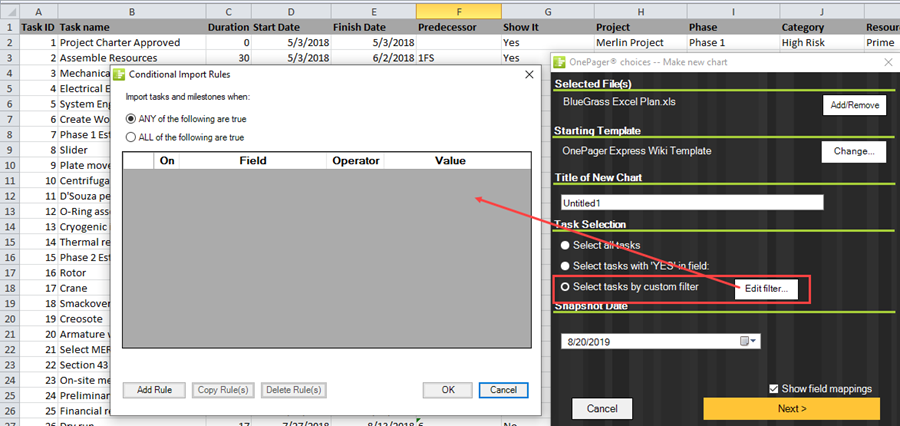
- a) The Conditional Import Rules form is shown in its initial blank state above.
- b) The rules entered become part of any chart subsequently created or updated and are saved with the chart.
- c) If you later, create or update a snapshot using a Flag field, OPX saves the Flag field and clear the Conditional Import Filters rules.
- d) Conditional Import Filter rules are typically entered when a chart is first created in the NEW workflow.
- e) After a chart is created, rules can be added later for the UPDATE workflow via the OnePager Choices form invoked either from the OnePager Start form or the Chart Editor (Custom Update… button. These workflows are described later in the examples accompanying this article.
Add a Rule
2) With the Custom Import Rules form visible and blank, click the Add Rule button to create a new empty row as shown below:
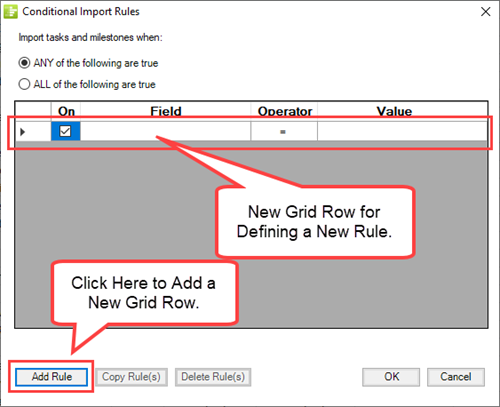
3) There are five cells shown for the new rule grid row above.
4) The first two cells are used as follows:
- a) The first two cells are used as selection cells.
- b) The first left-most cell, when clicked, allows you to use the Copy Rule(s) or the Delete Rule(s) buttons.
- c) The second cell from the left is a checkbox used to activate or deactivate the rule itself. If the checkbox is unchecked, OPP does not apply the rule when performing the import function.
- d) The Field cell of a grid row (third from the left) has a dropdown menu that allows you to select a Microsoft Excel source plan field to use in creating the selected criterion for import. When the dropdown menu is selected, the Field cell looks something like this:
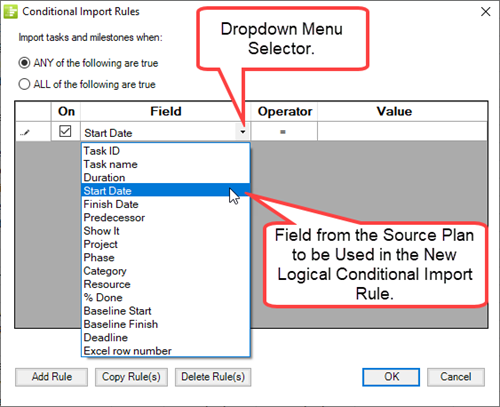
5) When a source plan field is selected, the name is displayed in the Field cell of the new Custom Import Filters rule row.
6) The look of the rest of the new Conditional Import Filters rule grid row depends on the type of source plan field selected. These types are discussed next.
Date and Numeric Fields
7) When source plan date or numeric field types are selected in the Field cell of the rule grid row, the Operator field dropdown provides the options shown below:
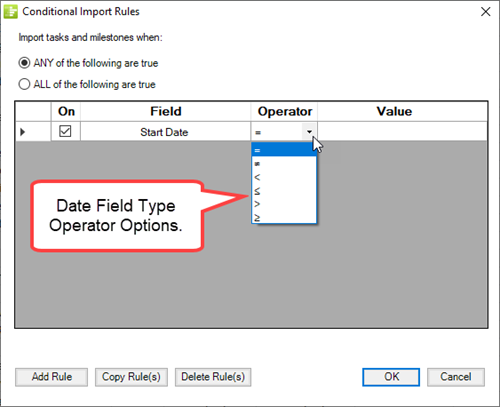
- a) These are the conventional six (6) logical operators used consistently in OnePager for date and numeric types. They are the same Operators used in OnePager for Conditional Formatting.
- b) See the article at Conditional Formatting Overview-OnePager Express 11.2.1-70 for complementary details on the use of these logical operators.
8) The Value cell in the rule grid row in the example above resolves to a date.
- a) Clicking on the Value cell in the grid row access the OnePager calendar form as shown here:
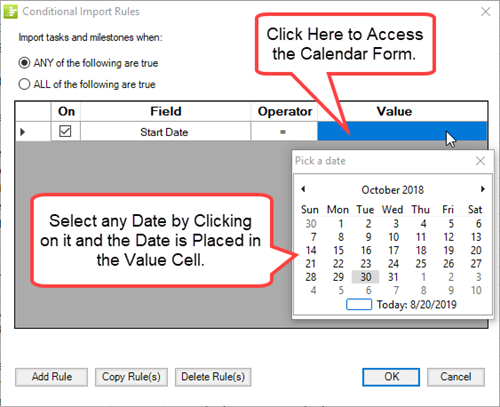
- b) Clicking a specific date in the calendar form placed that date in the Value cell and closes the date form.
- c) This completes the process of defining the first Conditional Import Filter rule at which time you can add another rule or modify the existing rule.
- d) If you are finished defining your Conditional Import Filter rules, click the OK button to close the form.
9) When any or all of the logical rules in the Conditional Import Rules form are evaluates to TRUE on the selected Field in a Microsoft Excel source plan row, the source plan row is imported. Otherwise the source plan row is skipped.
Text Fields
10) When source plan text fields are entered in the Field cell of the Conditional Import Rules form's row, the Operator field dropdown provides the options shown below:
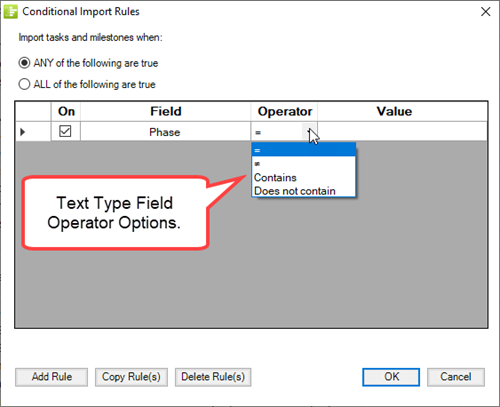
11) These are the conventional four (4) logical operators used consistently in OnePager for the text type.
- a) They are the same Operators used in OnePager for Conditional Formatting.
- b) See the article at Conditional Formatting Overview-OnePager Express 11.2.1-70 for complementary details on the use of these logical operators.
12) For the Value cell in the grid row, OnePager expects a text string.
- a) Enter your text string by clicking on the Value cell and typing the desired text string.
- b) After typing your desired text string, click anywhere in the form and the Conditional Import Filter rule is complete.
- c) This completes the process of defining this Conditional Import Filter rule at which time you can add another rule or modify the existing rule.
- d) If you are finished defining your Conditional Import Filter rules, click the OK button to close the form.
13) When any or all of the logical statement evaluate to TRUE on the selected Field in a Microsoft Excel source plan row, the row is imported. Otherwise the source plan row is skipped.
Boolean Fields
14) When Microsoft Excel Boolean field types are entered in the Field cell of the Conditional Import Filters rule grid row, the Operator field dropdown provides the options shown below:
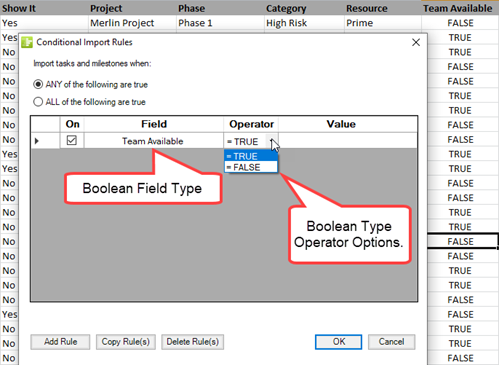
15) These are the two (2) conventional Boolean logical operators used consistently in OnePager for the Boolean type.
- a) They are the same Operators used in OnePager for Conditional Formatting.
- b) See the article at Conditional Formatting with Boolean Fields for OnePager Express 11.6.1-70 for complementary details on the use of these logical operators.
16) Boolean types are a special case as the Operator and the Value in OnePager are combined into one cell of the Conditional Import Filters rule grid row - the Operator cell. Accordingly, the Value cell in the grid row is disabled.
17) When any or all of the selected Field is TRUE (or Yes) in a Microsoft Excel source plan row, the source plan row is imported. Otherwise source plan row is skipped.
Text Type Fields Used As Flags in OnePager Express
18) OPX treats Microsoft Excel Text type fields as Flag fields to control row imports.
19) Accordingly, when text type fields are used for Conditional Import Filters rules, OPX makes the import decisions based on whether the cell either contains or does not contain to required Value cell’s content as shown below:
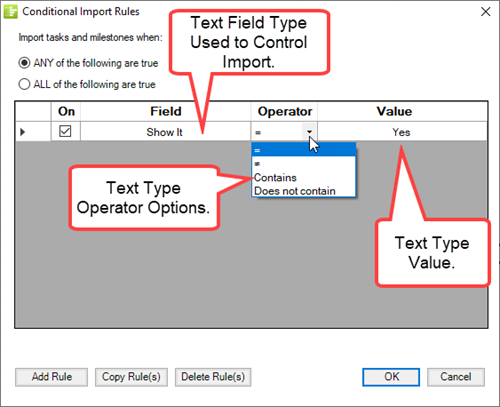
- a) In the case shown above, Microsoft Excel source plan rows are imported only if the row contents of the Shot It1 Microsoft Excel source plan field contain a Yes.
- b) You can also use the equal or not equal Operators being careful that the Value contents in the Conditional Import Rules form row is exactly as specified in the Microsoft Excel source plan row.
- c) We want to emphasize the flexibility that Conditional Import Filters adds to the way you can import rows from your Microsoft Excel source plan.
- d) You can, therefore, formulate sets of Conditional Import Filters rules to controls imports using all available types of Microsoft Excel fields.
- e) For the logical statement to be TRUE, hence cause OPX to import the corresponding Microsoft Excel source plan row, the contents of the Operator cell in the Conditional Import Filters rule row must match the type and value in the Microsoft Excel source plan.
- f) Additionally, the logical relationship must be TRUE to make OPX act on the condition.
Boolean and Numeric Types Used as Flags in OnePager Express
20) OPX also recognizes Microsoft Excel Boolean types and Numeric types with 0 or 1 contents as Boolean types as well within the Conditional Import Rules form.
- a) OPX treats such Microsoft Excel Fields as Boolean types in the same way as described in the previous sub-section.
- b) When these Microsoft Excel Boolean types are entered in the Field cell of the Conditional Import Filters rule row, the Operator cell dropdown provides the options as shown above.
- c) There are the two (2) conventional Boolean logical operators used consistently in OPX for the Boolean type. They are the same Operators used in OPX for Conditional Formatting.
- d) See the article at Conditional Formatting with Boolean Fields for OnePager Express 11.6.1-70 for complementary details on the use of these logical operators.
- e) When the selected Field is TRUE (or Yes) in a Microsoft Excel source plan row, the row is imported. Otherwise it is skipped.
21) We want to emphasize the flexibility that Conditional Import Filters adds to the way you can import rows from your Microsoft Excel source plan.
22) You can formulate sets of Conditional Import Filters rules to controls imports using all available types of Microsoft Excel fields and use operators that let you select ranges of values and more complicated combinations of criteria.
The ANY and ALL Radio Buttons
23) Just below the top of the Conditional Import Filter Rules form there are two radio buttons which control how the Conditional Import Filter rules are used as a group.
24) The ANY of the following rules are true radio button, if selected, acts as a logical OR function for all enabled rules in the form.
- a) If this radio button is selected, OnePager examines the rules in the form and imports only the tasks and milestones that satisfy those rules individually.
- b) The tasks and milestones that are imported under this scenario meet one or more of the enabled rules in the form.
- c) Tasks and milestones from the source plan that do not meet any of the enabled rules in the form are not imported.
25) The ALL of the following rules are true radio button, if selected, acts as a logical AND function for all enabled rules in the form.
- a) If this radio button is selected, OnePager examines the rules in the form and imports all the tasks and milestones that satisfy all the rules.
- b) The tasks and milestones that are imported under this scenario do meet all of the enabled rules in the form.
- c) Tasks and milestones from the source plan that do not meet all of the enabled rules in the form are not imported.
Editing an Existing Filter Rule in the Conditional Import Rules Form
1) Suppose you’ve composed two Conditional Import Filters rules in the open Conditional Import Rules form and you want either of them to apply. That is, the radio button for ANY of the rules are true is clicked ON as shown below:
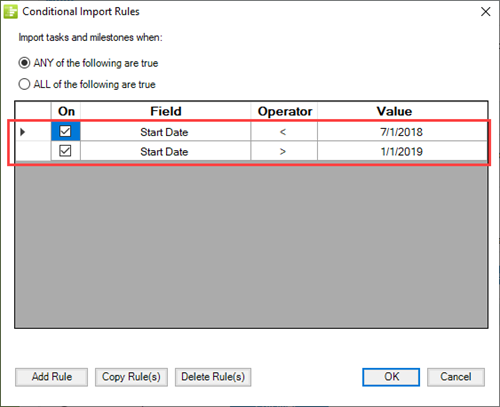
2) Now further suppose, after reviewing these two rules, that you realize that you can not import any tasks/milestones that happen to Start on 7/1/2018 because the current rule is based on the less than logical Operator.
3) To make the change in the Operator cell, click on the cell’s contents which highlights the cell in blue and accesses the dropdown menu button which you should click.
- a) When you do this the Conditional Import Rules form looks like this:
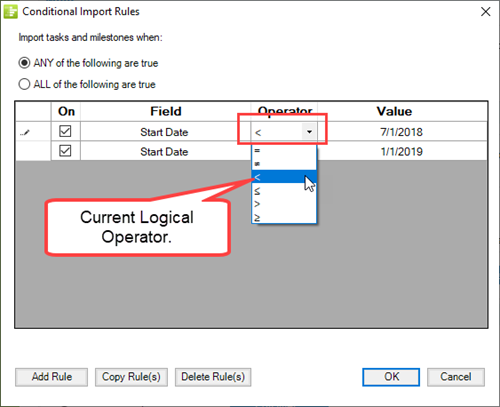
- b) To change the rule, access the Operator dropdown menu and then select the less than or equal Operator.
- c) As a result the edited Operator is displayed in the Operator cell of the second rule as shown here:
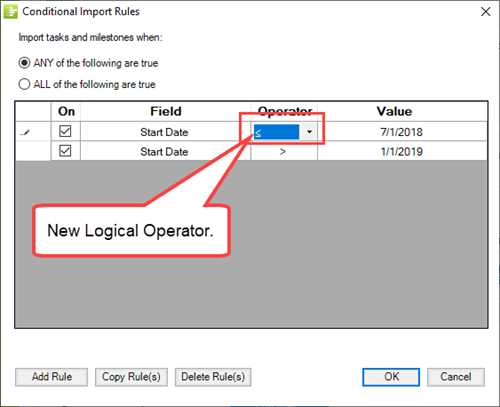
4) Any Field, Operator, or Value cell can be edited in this way.
- a) Additionally, the On cell can be toggled to control the Conditional Import Filters rule's participation in the import process.
- b) Finally, you can switch between the two radio buttons at the top of the form in order to change the relationship among the rules from OR to AND or vice versa.
5) The edits described above can be made to the Conditional Import Rules form regardless of the OPC mode in which you are working (i.e., NEW and UPDATE).
6) Also, you can access the Conditional Import Rules form from the OPC form as many times as needed to accomplish your presentation goal. OnePager saves the content of the last edit you make to the Conditional Import Rules form.
7) When satisfied with the structure of your import rules, click the OK button at the bottom of the form to return to the OPC form. Now you are ready to create a new chart.
Copying an Existing Filter Rule in the Conditional Import Rules Form
1) The Copy Rule(s) button is provided in the Conditional Import Rules form to facilitate the creation of additional rules.
2) To copy an existing rule to create a new rule, first select the rule grid row from which you wish to copy as shown below:
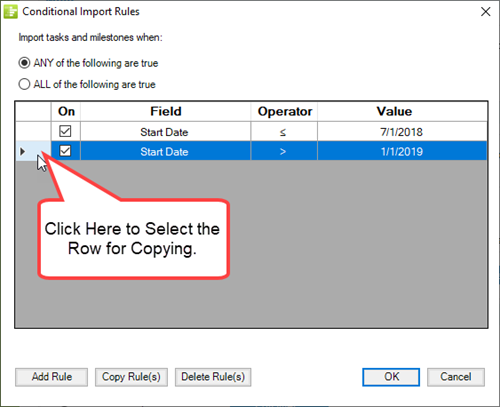
3) Once the desired grid row is selected, clicking the Copy Rule(s) button copies the contents of the rule selected into a new grid row as shown below:
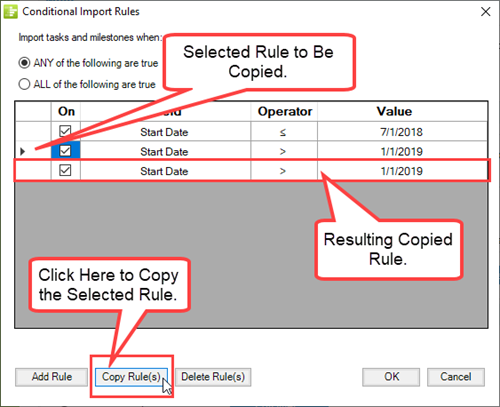
4) At this point you can edit the copied grid row in the manner described previously.
5) When you are finished, the new set of three rule grid rows can look like this:
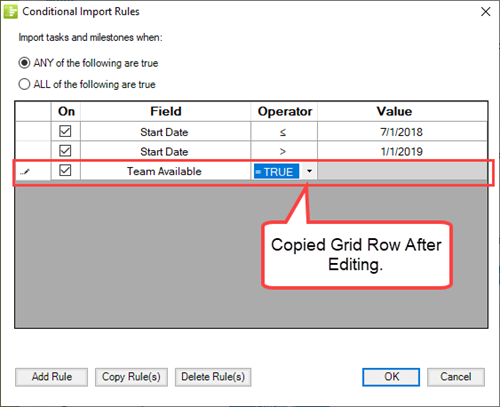
6) When satisfied with the structure of your import rules, click the OK button at the bottom of the form to return to the OPC form. Now you are ready to create a new chart.
Deleting an Existing Filter Rule in the Conditional Import Rules Form
1) There are times when a particular Conditional Import Filters rule no longer serves a purpose.
2) You can select the rule grid row you want to delete and then click the Delete Rule(s) button to remove the rule grid row from the form.
3) The process for deleting a rule parallels the process for copying a rule grid row in that the you must first select the desired grid row to delete by clicking the left-most cell in that rule’s grid row.
4) Once the selection is made, click the Delete Rule(s) button and OnePager first shows a warning message asking if you really want to delete the rule grid row as shown below:
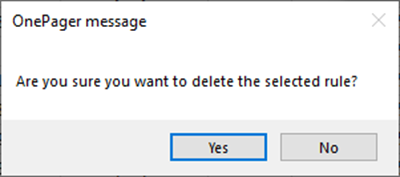
- a) If you select the No option, OnePager abandons the rule deletion operation and the warning message disappears leaving the selected rule grid row selected.
- b) If you select the Yes option, OnePager removes the warning message, deletes the selected rule grid row, and leave the Conditional Import Rules form showing the remaining rule grid rows, if any.
5) When satisfied with the structure of your import rules, click the OK button at the bottom of the form to return to the OPC form.
Switching from Flag Fields to New Conditional Import Filters Rules
1) When you click the NEW button, the OPC form is accessed.
2)The process for building a new chart with Conditional Import Filters is the same with the exception that instead of using Flag fields from your source plans you, instead, are going to use the Conditional Import Rules form from the OPC form as shown below:
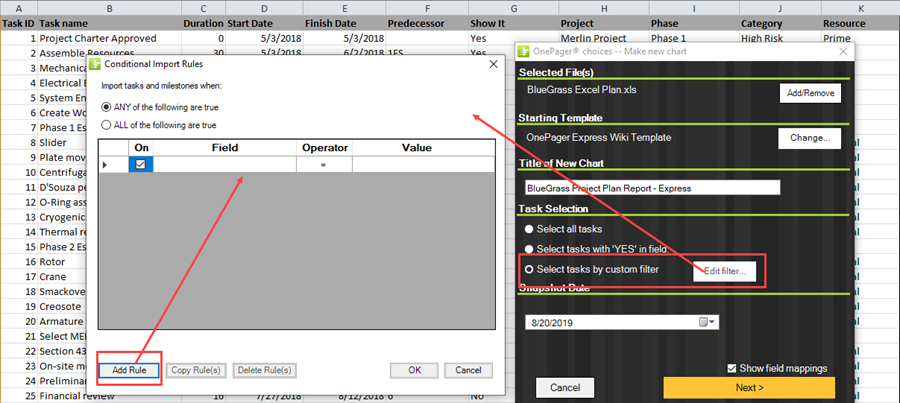
- a) In the illustration above, in the Task Selection section of the OPC form, the Select task by custom filter radio button is clicked on.
- b) This action immediately accesses the Conditional Import Rules form also shown above.
3) At this point you can Add Rules to the form, Copy Rules, Delete Rules, or edit existing rules.
Switching from Conditional Import Filters Rules to Flag Fields or Selecting all Tasks
1) If you subsequently decide after composing one or more Conditional Import Filters rules and clicking OK on the Conditional Import Rules form that you want to use Flag fields instead, you can revert back to either of the two other Task Selection options provided in the OPC form shown above. (OnePager only supports one Task Selection option at a time.)
2) To do this, click either of the other two radio buttons to Select all tasks, or Select task with ‘Yes’ in field:
3) When you click the Select all tasks button there is no further action you need to take on the OPC form.
4) However, if you click the Select tasks with ‘Yes’ in field: you now need to select a Flag field from your source plan's list of available Flag or Numeric fields in the dropdown provided as shown below:
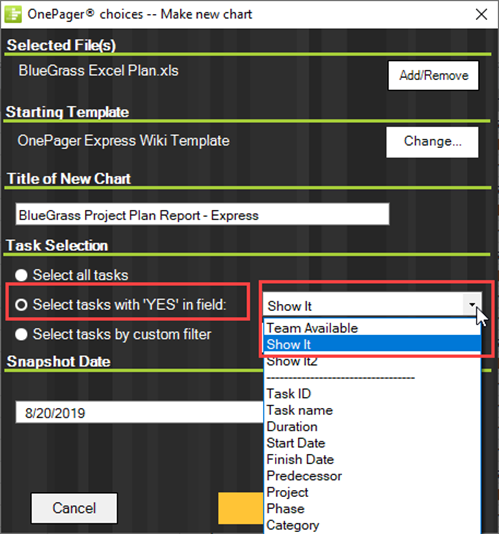
5) In these circumstances where you’ve switched from using Conditional Import Filters rules to either selecting all tasks, or selecting tasks using a Flag field, OnePager discards any Conditional Import Filters rules associated with the chart.
Adding, Editing, Copying, and Deleting Conditional Import Filters Rules
1) Managing Conditional Import Filters rules was discussed in previous sub-sections in this article.
2) Please follow the reference links provided below for details on adding, editing, copying, and deleting of Conditional Import Filters rules:
- a) Adding a new rule: Adding a Filter Rule to the Conditional Import Rules Form.
- b) Editing an existing rule: Editing an Existing Filter Rule in the Conditional Import Rules Form.
- c) Copying a rule: Copying an Existing Filter Rule in the Conditional Import Rules Form.
- d) Deleting a rule: Deleting an Existing Filter Rule in the Conditional Import Rules Form.
A Simple Example Using Conditional Import
1) In this section and the one to follow, we’ll provide a couple of examples of a workflow that you might find most useful. First we’ll provide a simple example and then extend it to a more advance use of the workflow.
Setup
2) Suppose you have a situation where you want to focus the attention of your audience on a particular set of tasks that have the following attributes:
- a) Where tasks/milestones Start Date occur on or after July 1, 2018 but no later than January 1, 2019.
- b) Where swimlanes in the chart represent the Phases of the project
- c) Where the text column represent the Resources associated with each displayed task, respectively.
- d) And where the Legend is organized by Category.
3) Let’s further suppose that we are going to use the BlueGrass Project Plan Microsoft Excel source plan file as input to OnePager.
4) Finally, we will use a variant of the the Single Chart Gantt View – Detailed Template, distributed with OnePager, adapted to this Wiki example.
5) To begin with, the source plan looks like this:

6) The Main tab of the Template used for this example looks like this:
7) If we launched OnePager with the above Template, the tasks and milestones included in the chart become those associated with Yes in the Show It field in the source plan above.
8) This is not what we want so we first have to change the task and milestone selection criteria using the Conditional Import Filters feature as we’ll show next.
Changing the Task and Milestone Selection Criteria
9) With the conditions established in the sub-section above, let’s go ahead and launch OnePager from the Microsoft Excel tool bar and access the OnePager Start form as shown below:
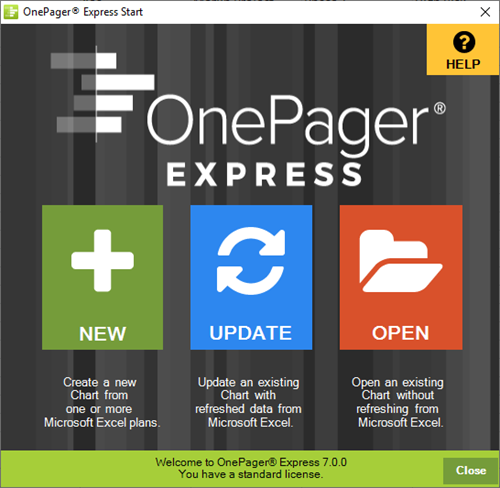
10) Next, click the NEW button which accesses the OnePager choices (OPC) form shown where the chart name is already filled in:
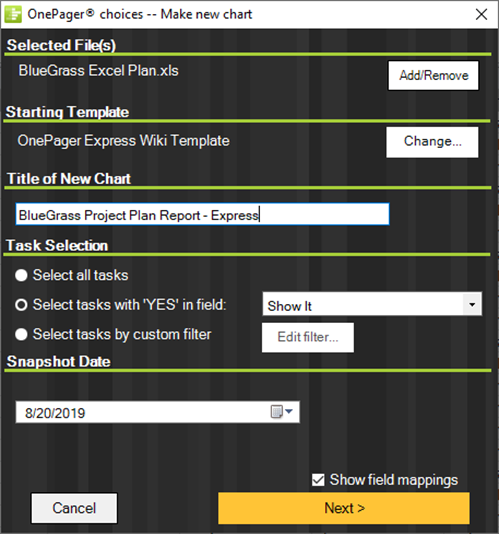
11) We’ve gone ahead and confirmed that we have the correct source plan and we’ve filled in the Title of New Chart.
12) We see that the Task Selection criteria are based on the contents of the Show It field, and we don’t want this field to be used.
13) We have two ways to invoke the Conditional Import Filters feature and we’ll explain each below:
Using the OnePager Choices Form to Create Conditional Import Filters
14) For this first technique, click on the Select tasks by custom filter radio button, that accesses the Conditional Import Rules form as shown below:
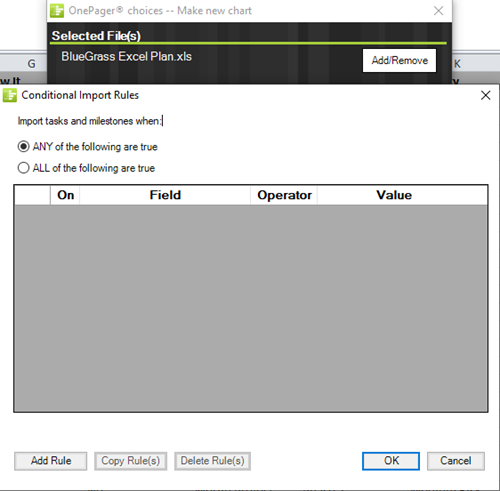
15) Next, we’ll enter the two Conditional Import Filters we specified in the previous subsection and make sure the ALL of the following are true radio button is selected so the Conditional Import Rules form looks like this when we are done:
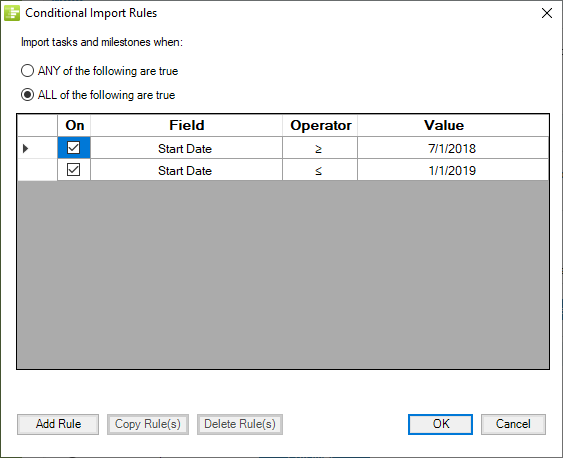
16) From here we go ahead and click the OK button on the Conditional Import Rules form and, once back at the OPC form, go ahead and create the chart.
17) However, before we do that we want to show the alternative way to enter Conditional Import Filters rules.
Using the Template to Create Conditional Import Filters
18) To illustrate this second technique let’s roll back to the OPC form we saw above and notice that the checkbox labeled Show field mappings is checked ON and the button below the checkbox is called Next>.
19) Now click the Next> button which takes you to the second page of the OPC form which looks like this:
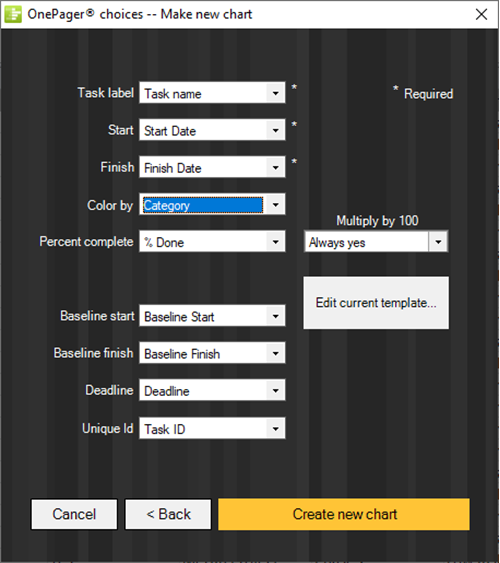
20) Next, click the Edit current template… button which accesses the current Template as shown below. Then, navigate to the Main tab as we have done here and note the radio button titled Select tasks by custom filter:
21) When the Select tasks by custom filter radio button is clicked, the Conditional Import Rules form is accessed and you can enter the two rules we specified in for this example as we’ve shown below:
Creating the Chart
22) After entering the two Conditional Import Filters rules, as shown above, click the OK button on the Conditional Import Rules form and then the Save and Use button at the bottom of the Template form.
23) These actions access the second page of the OPC form, shown earlier; where you can click the Create new chart button and OnePager creates the chart as shown here:
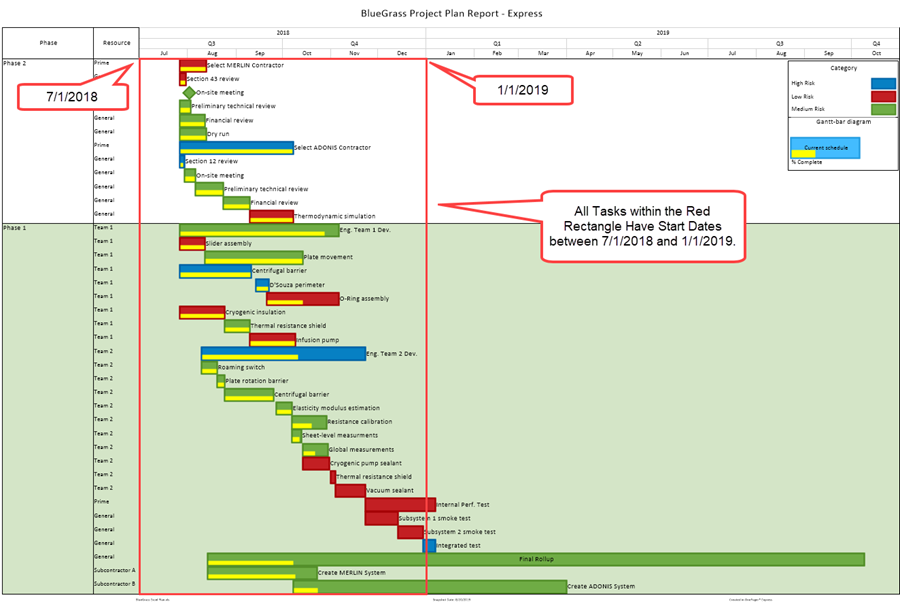
Editing the Chart
24) If we like, we can edit the chart by adding the two text columns specified to show Start and Finish dates.
25) This edit is implemented by using the Text Column feature as shown in the article at: Editing with the Chart Properties form (Portal) 21.0.1-70.
26) When these actions are taken the chart looks like this:
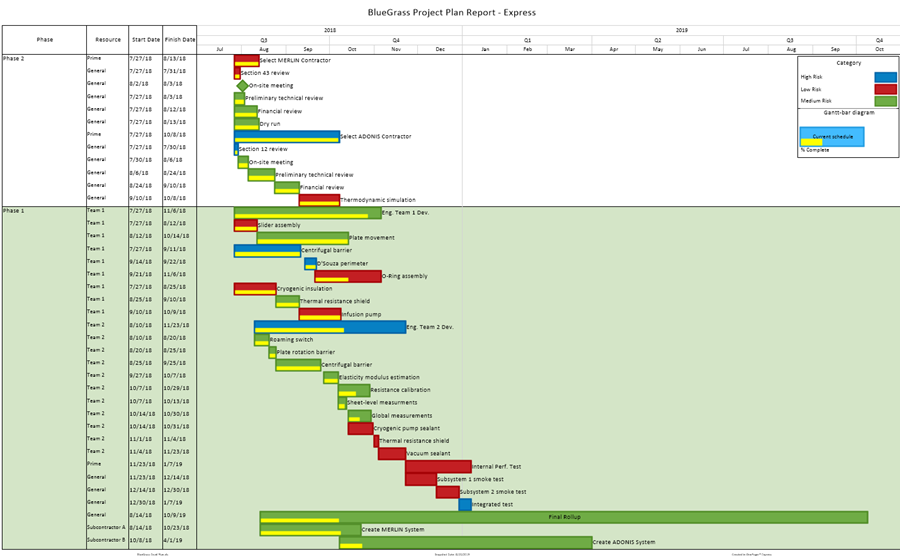
An Advanced Example Using Conditional Import
1) The advanced workflow example presented in this section on Conditional Import Filters rules is a continuation of the example in the previous section.
2) If you haven’t read or reviewed the example above, we suggest that you do so before reading on in this section.
Continuation of Previous Example
3) What we intend to show in this section is how to proceed from the creation of the chart in the previous section through successive edits and replacements to get to a chart that is perfect for a specific schedule conversation.
4) To set the stage, let’s establish some further guidance for the final visual presentation:
- a) It needs to be very focused on the apparent trouble spot; say with those tasks and milestones whose Category is Medium Risk.
- b) There needs be as few tasks as possible so as to keep the audience’s focus on the real project management issue.
- c) The presentation of the schedule issues needs be on one page.
5) Given the above guidance, we need to restructure the chart from the previous section.
Using Conditional Import Filters to Update a Chart through Replacement
6) Looking back at the chart from the previous sub-section, we see that it contains tasks from all the Categories during the time interval we specified in the original set of Conditional Import Filter rules.
- a) Our guidance says that we want to focus more on those tasks and milestones that are Medium Risk as established by the Category field in the Microsoft Excel source plan.
- b) To do this, we’ll use the Conditional Import Filters feature to refine our import criteria and replace the chart with tasks/milestones that meet the Start criteria and the Category value criteria we need.
7) To modify the Conditional Import Filters rules do the following steps:
- a) First we go to the chart and bring up the Chart Properties form at the Main tab.
- b) Next, we click the Select tasks by custom filter radio button to bring up the Conditional Import Rules form.
- c) Then, we use the Add Rule button to make a new grid row for the third rule and compose the third rule to specify Category in the Field column, an equal sign in the Operator column, and the word Medium Risk in the Value column.
- d) When the new grid row rule is added, the new (third) rule, the forms looks like this:
8) Now do the following steps:
- a) Click the OK button on the Conditional Import Rules form.
- b) This closes the form and take you back to the Chart Properties form’s Main tab.
- c) Here, click the Apply button only.
- d) This applies the change to the chart but keep the Chart Properties’s Main tab open.
- e) Before doing anything else, go to the Chart Editor’s tool bar and select the Data tab.
- f) When you are finished with these steps, the Chart Editor and the Chart Properties form's Main tab looks like this:
- g) When you click the Apply button on the Chart Properties form the chart does not change appearance. This is because the actions taken only update the Conditional Import Filter rules and no import action has yet to take place.
9) The last step in this workflow is to click the Replace Snapshot button which is the left-most button on the Data tab tool bar.
10) This is the action that tells OnePager to update the chart by re-importing the source plan data with task selection controlled by the three rules now active in the Conditional Import Rules form.
11) When the OnePager replace process completes, the chart is updated to not only restrict the start dates but also to restrict the Category in the chart, like this:
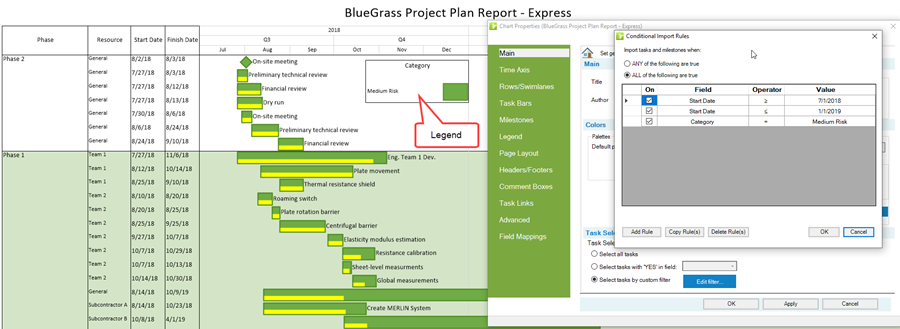
Summary of First Chart Replacement Iteration
12) To summarize what we’ve done, we’ve accomplished the following:
- a) Used the original chart in conjunction with the Conditional Import Rules form to specify an additional rule that further focus the tasks in the chart to our specific schedule discussion.
- b) Used the Replace Snapshot button to tell OnePager display the updated chart using all three Conditional Import Filter rules defined.
Second Chart Replacement Iteration
13) The chart we created above still isn’t quite ready for our schedule conversation.
- a) Because, say, our schedule conversation is going to focus on reviews that are in the schedule, it might be a good idea to only show tasks which are review tasks by nature and name.
- b) To do this, we need to add a fourth Conditional Import Filter rule that will only import tasks in the current set of task displayed above that involve reviews.
14) To do this, we'll add the fourth rule to the Conditional Import Rules form as shown below:
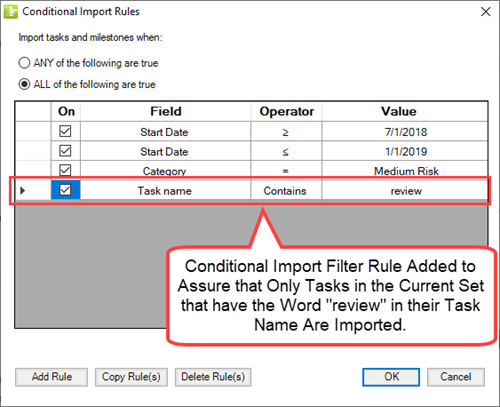
15) We’ll use the same sequence of steps that were used in the first replacement iteration we described above.
- a) In the open Chart Properties form, click the button to bring up the Conditional Import Rules form and add a fourth rule restricting import to tasks/milestones that have the word review in their Task name field.
- b) With the above rule added, click the OK button in the Conditional Import Rules form and after it closes, click the Apply button on the bottom of the Chart Properties form’s Main tab.
- c) The appearance of the Chart Editor is like this:
16) The last step is to click the Replace Snapshot button on the OnePager Data tab tool bar.
17) OnePager performs the snapshot replacement and the chart looks like this:

Summary of Second Chart Replacement Iteration
18) The chart in the illustration above now meets all the two Start Dates, Category, and Task name criteria using four Conditional Import Filter rules to support the schedule conversation.
19) This was all done by an iterative workflow that couples updates to the Conditional Import Rules with the Replace Snapshot button on the OnePager tool bar’s Data tab.
20) All that needs to be done now is to copy the chart into the schedule presentation media.
Some Additional Comments on this Workflow
21) It’s important to remember for this workflow that you always use REPLACE the single snapshot in the chart.
22) We advise against ADDING a snapshot as you refine your rules because this can result in empty rows for tasks that were present under a previous set of rules but are now absent.
23) If you want to begin the workflow by OPENING a previously created chart, it is essential, as mentioned above, that there is a clear and viable path from the chart to its source plan(s).
24) You can confirm this and fix any problems by clicking the Selected Files button on the Data tab.
Related Links
Basic Workflows (Portal) 7.0.1-70
Conditional Formatting (Portal) 11.0.1-70
Using the OnePager "Data" Tab's "Selected file(s)" Button 7.17.1-70
OnePager Express Import of Data from Microsoft Excel 4.0.1.4-70
Understanding Charts and Snapshots for OnePager Pro 4.0.1.1-70
Understanding Charts and Snapshots for OnePager Express 4.0.1.2-70
Editing with the Chart Properties form (Portal) 21.0.1-70
(7.18.2.1-70)